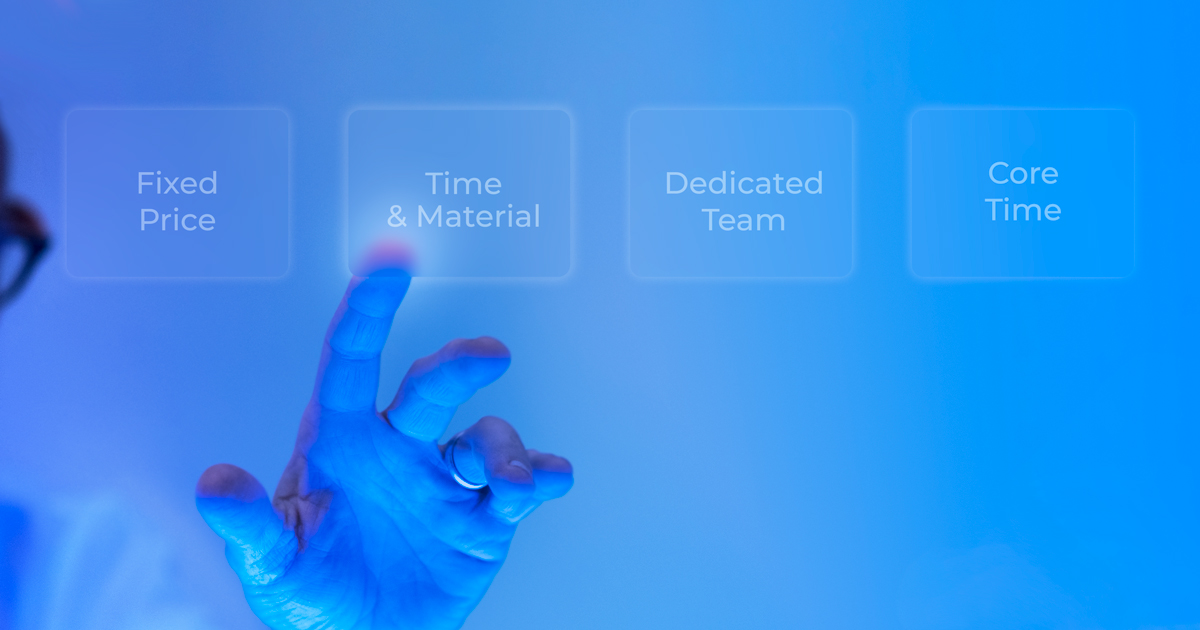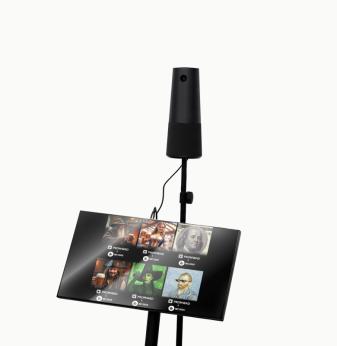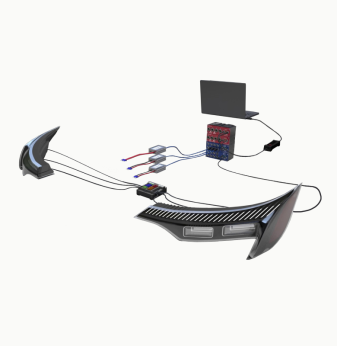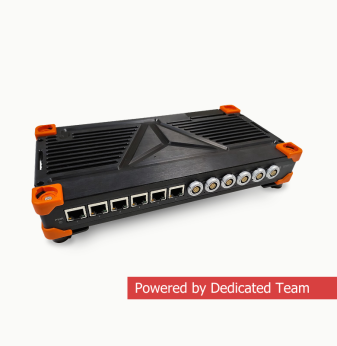How to Choose the Best Pricing Model for Your Software Development Project


When outsourcing a software development project, choosing the best pricing model is essential. What is the optimal cooperation format for your specific project? This article will help you answer this question. We will cover four business models in software engineering: Fixed Price, Time & Materials, Dedicated Team, and Core Time.
Contents
Fixed Price
The Fixed Price model has a fixed budget, minimum uncertainty, strict deadlines, and an agreed scope of work.
At first glance, it may seem that this is the most beneficial model for you as a customer: you will get a finished product on time and within budget. This is true, but the project's cost under this model will include all the risks on the part of your contractor, and the final price may be 30–50% higher than in a Time & Materials contract.
What is essential for successful collaboration within the Fixed Price model? A detailed specification to describe your project. The specification plays a key role: it helps your contractor define the scope of work, predict risks, manage resources, and, ultimately, estimate the project's cost before signing the contract.
It's impossible to start a project without a proper level of specification. This is why your contractor, if it is an experienced and conscientious company, will be very keen to review the project description in detail, ask clarifying questions, agree with everything and put it into your contract.
After the specifications and the final contract are agreed upon, your project management costs will be kept to a minimum.
Features of the Fixed Price model
This pricing model has special features to consider:
- Relatively high hourly rate: the cost of a fixed-price contract will be higher than other models, as it involves potential risks on your contractor's side because your service provider takes full responsibility for the result — on time and in compliance with your requirements.
- Lack of flexibility. As all the stages of the project are prescribed in advance, with fixed budgets and deadlines, it is difficult to make changes as the project progresses: to implement them, you have to stop the project, clarify the requirements, reassess and put the new requirements into the contract. The project timeline will consequently shift, and the budget will increase.
- The risk of changes in the market and external conditions: the product under development may become irrelevant, or the available components may disappear. This will lead to a revision of your requirements and an extension of deadlines and budgets.
In which projects Fixed Price should be used?
This pricing model is best suited for:
- short-term projects — up to 3 months;
- projects with a limited budget;
- MVP (minimum viable product) development.
Fixed price software development is not the best choice for large, complex projects and development from scratch, where you have many unknowns, and requirements change as the work progresses. This model lacks the flexibility to meet requirements and the ability to make changes quickly for these kinds of projects.
Time & Materials (T&M)
When you choose the T&M software development, you negotiate with your contractor to fix the cost per hour and leave the number of hours per project as a variable value.
What is essential for successful collaboration within the Time & Materials model? Control the scope of work on your side and regular reports on the contractor's side.
The contractor allocates a team, and you adjust the work scope and the project budget by adding or reducing development tasks. You only pay for the team's time and materials (necessary equipment, debugging boards, software licences, and so on).
Features of the Time & Materials model
The main advantage of this model is flexibility. You can make changes to the list of features of a device or software, change the team, adjust the plan and scope of tasks, or even close your project ahead of schedule.
At the same time, this flexibility imposes an obligation on you: you will need to provide the team with the necessary documentation, access and monitor the progress of the work according to the terms of reference.
It is important to realise that flexibility is both an advantage and a disadvantage of the model, as constant changes to the project may delay getting the product to market.
In which projects Time & Materials should be used?
This pricing model is best suited when:
- your software project is long-term;
- requirements may change during the project;
- you need full control over the progress of the work.
Dedicated Team

The photo shows our engineer testing software on a dev board. When working within the Dedicated Team model, we usually buy lab equipment at our own expense.
This format has much in common with the Time & Materials model, but with two differences: a contract usually lasts a year or more, and your team is not working on one project but is assembled for a variety of your tasks.
Here is an example from our experience: Promwad team worked on a telecom project for a European customer for four years as a dedicated software development team. This collaboration started with a test project with a group of three engineers, and in the end, our customer got a dedicated team with thirty specialists.
What is essential for successful collaboration within the Dedicated Team model? It is important to define how you share responsibility with your contractor.
Often there are no clear specifications of the final product in this type of cooperation. Requirements may change over the project's life, depending on your plans and market requirements. Therefore, you should be prepared to share risks with your contractor: new product requirements can result in increased timing and budgets.
In this type of partnership, you are responsible for managing your product, setting goals and paying for the team's work monthly. The contractor forms a team for you to implement the project and is responsible for the result of their work.
Features of the Dedicated Team model
Each party has its own area of responsibility. At Promwad, we take on the following tasks as a dedicated software engineering team:
- help our clients choose the optimal development platform, components, and technology stack;
- plan and manage the project, control the deadlines; and advise on the development process;
- form teams with the necessary skills, if required — train them;
- provide full employment of the team and deal with all organisational matters: workplace and engineering lab equipment, IT infrastructure, all accounting and legal issues.
The benefits you get with the Dedicated Team model:
- Reliable and predictable results in terms of budget, timeframe and quality level.
- Access to internal competencies within the contracting company and the ability to scale the team for new tasks.
- Regular reporting and transparency: you get a detailed progress report at the end of each iteration.
- Flexibility: you can manage the scope of tasks, as in the Time & Materials model.
In which projects Dedicated Team should be used?
This model is suitable for large and long-term projects if, for some reason — a legal, technological, or financial one — you want to avoid hiring in-house specialists and you need fast growth.
It is beneficial to build a dedicated team if your project requires rare specialists unavailable locally or the cost of their services is high.
Core Time
With this software development business model, you invite specialists from different domains to your project on an as-needed basis. You are not hiring an entire team for the entire project but connecting a specific specialist to a specific task for a fixed period of time.
What is essential for successful collaboration within the Core Time model? You should define your requirements in detail and consider the risks of possible revisions. This need stems from the features of the model.
Features of the Core Time model
Similar to the Fixed Price model, this is a beneficial format of cooperation, but it has a significant limitation. A specialist is hired for such a job for a fixed time. If, after the agreed period, any unforeseen changes are required, there is the possibility that the same specialist will be involved in another project. You either have to wait or hire a new engineer. In the latter case, there is a risk of increasing costs: a new developer needs time to learn the solution, get acquainted with the requirements and continue work.
In which projects Core Time should be used?
This pricing model is suitable for short-term tasks with clear requirements.
Pilot Project
A pilot project is not a separate collaborative model in our list. This is a great opportunity for a safe start with a new contractor. You should take advantage of this opportunity before launching a full project for several reasons:
- Before forming a Dedicated Development Centre, you need to test the contractor, assess their level of expertise, and work out the interaction format. This will help minimise possible risks.
- You want to release a solution but are still determining if it will be in demand on the market. In this case, the solution is developed with limited functionality for a quick market launch to test your hypotheses.
Pilot projects can be launched within Time & Materials and Fixed-Price models.
How to choose the best pricing model

At Promwad, we evaluate your project: we calculate how much time and resources we will spend on it and then recommend the partnership format. If it is an R&D project, we almost always suggest the Time & Materials model. We offer the Dedicated Team model if the project is to last a year or more.
Any collaborative model is a viable one. But if it is not chosen with several factors, the final project budget increases and deadlines can shift. Here are the parameters we use in our project estimation:
- Project duration: if the project lasts a year or more, we offer a Dedicated Team. If the project lasts from 3 months to a year, the best option is Time & Materials. Why not a Fixed Price? This model is not flexible, the process of approval and changes is very long, and the changes are paid extra and above the budget. Also, Fixed Price has higher initial costs as there are a lot of risks: market changes, requirements, etc. You should have a clear understanding of the business model of your product and the possibility to further profit from it so that a high level of profitability will compensate for the cost of its development within the Fixed Price model.
- Need for changes: If you do not have clear requirements for the product at the start of the project, or they may change, you should use the Time & Materials model. You can start the project immediately, pause after the next iteration, test hypotheses and then continue or close the project prematurely.
- Level of involvement in the project: the fixed-price model does not involve you deeply in the project's development stages. You will be able to get information on the project's current status upon request, but you will not be able to influence its progress or make changes.
We have compared pricing models in software development according to the main criteria and put them together in the following table:
| Parameter | Fixed-Price | Time & Materials | Dedicated Team | Core Time |
| Terms | Fixed in the contract | Not specified or indicative | Not specified or indicative | Not specified or indicative |
| Quality control | Your contractor | You and your contractor | You and your contractor | You and your contractor |
| Cost | Assessment, internal, external and temporal risks, downtime are included | Paying only for hours worked | Paying only for hours worked | Paying only for hours worked |
| Possibility of changes to the project | Very limited | Available | Available | Available |
| Scope of work | Fixed | Not established | Not established | Fixed |
| Control and management of the scope | Your contractor | Divided between your contractor and you | Divided between your contractor and you | Divided between your contractor and you |
| Project size | ~ 500—1000 hours | ~ 1000 hours and more | A contract for a year or more | Small tasks, 100—200 hours per month |
| Product requirements | Defined before the project start | Can be changed | Can be changed |
Conclusion
Our team has experience in all the types of software development models mentioned above. Based on this experience, we can say that Time & Materials is the most beneficial and safest pricing for both parties: you don't need detailed specifications to start a project and can control its progress and make changes at any time, paying only for hours worked.
Clients usually switch to the Dedicated Team model, having successfully completed their project within the Time & Materials model, and if they want to continue our collaboration in the long term.
Core Time is suitable for small tasks. This model is not the most popular one because there is a risk that the right expert will be busy on another project if revisions are needed.
Fixed Price is the most convenient model only at first glance. If you dig deeper, it doesn't provide flexibility to make changes during the project, and the final cost can increase significantly due to the inherent risks.
If you are going to develop your hardware or software product but are unsure which pricing model is better for you, don’t hesitate to contact us — we will find the right option for you considering your goals, deadline and budget!
Our projects












